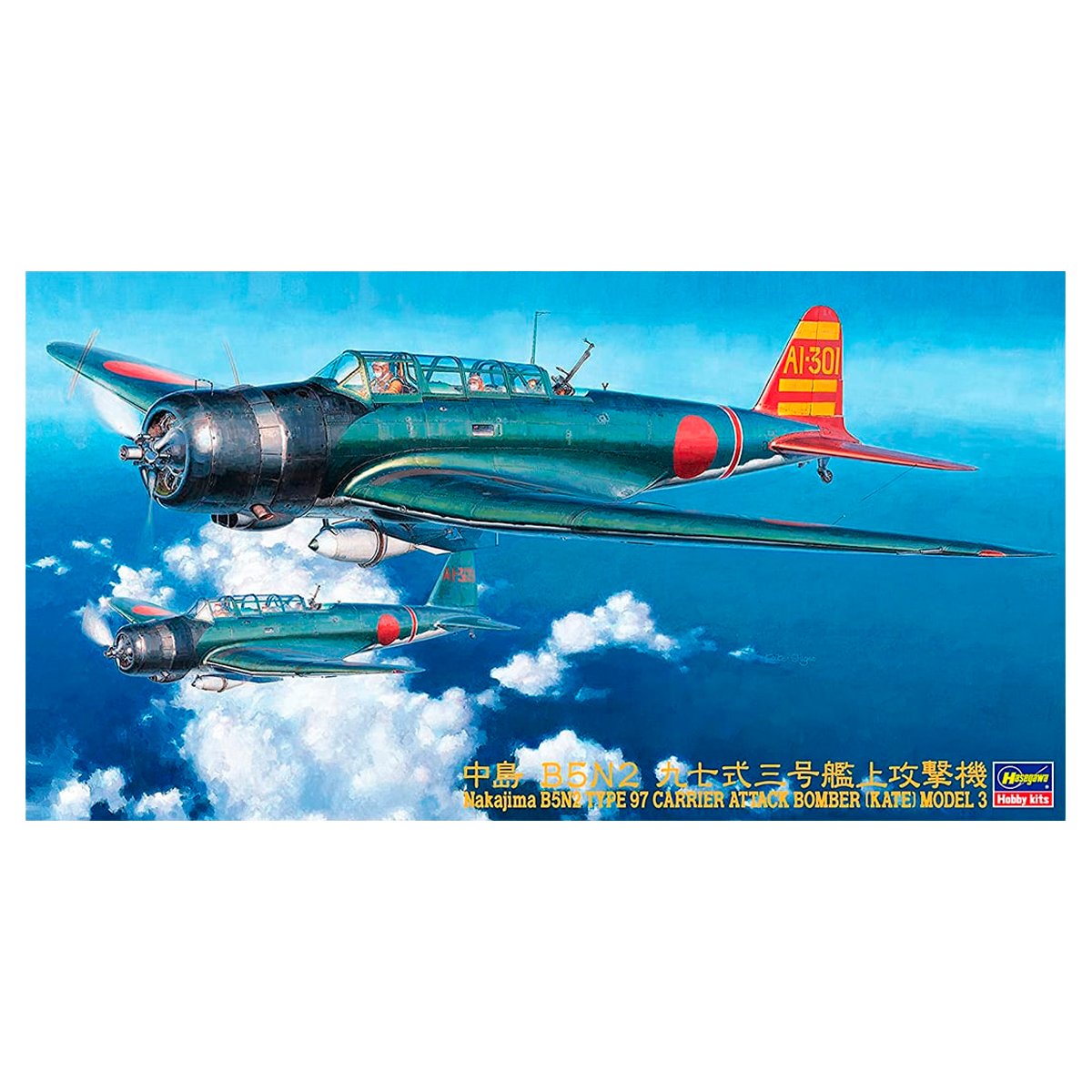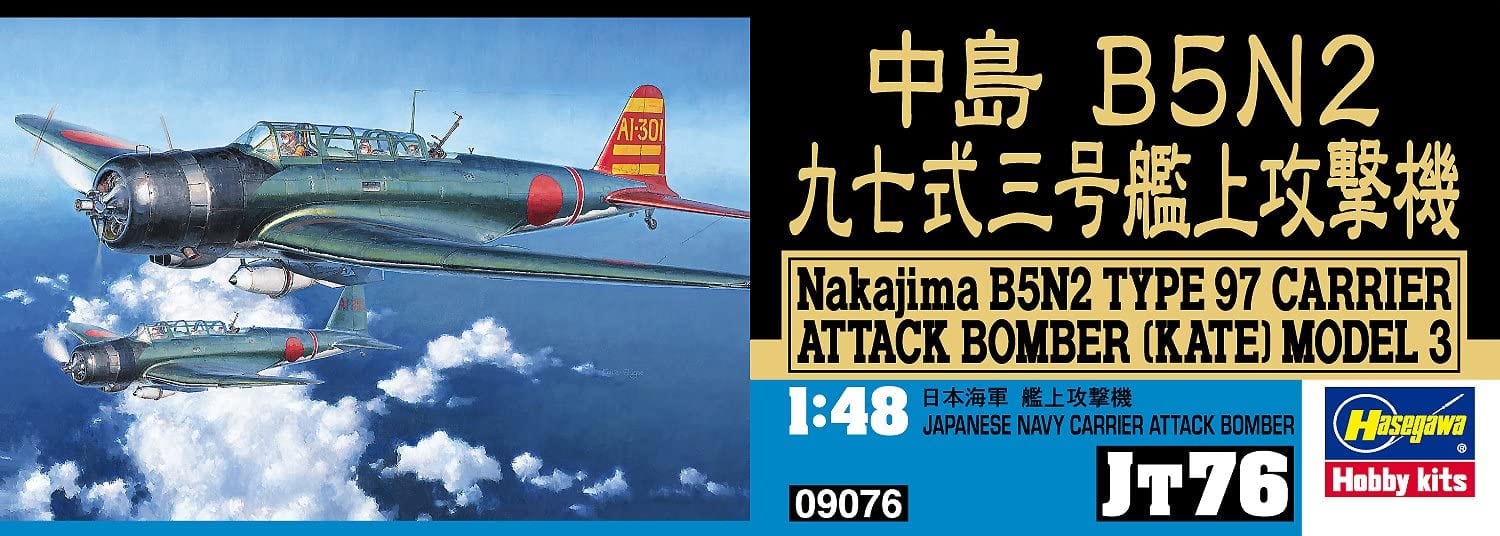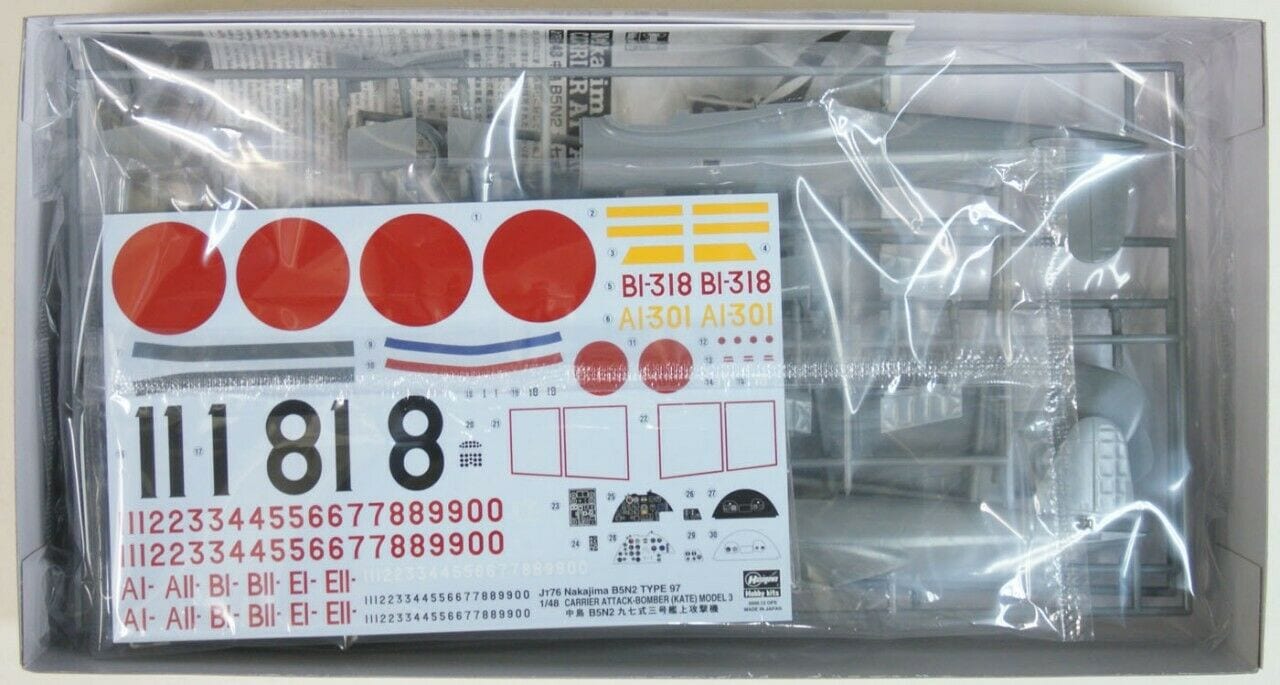JT76 – 1/48 Nakajima B5N2
27,95€
Out of stock

*Please check our Privacy Policies to see how to we use your personal data.
*Por favor revisa nuestra Política de Privacidad para ver como tratamos tus datos personales
Scale … 1:48
In 1935, the Japanese Navy
ordered both Mitsubishi and Nakajima companies to make prototypes under the name of Ten-Test Ship Attack Machine.
The requirements of the Navy are much higher than those of the 96th ship attack aircraft that were just adopted at the time, and at Nakajima, which received a prototype request , all of them were defeated by Mitsubishi in the competition for the major models of the Navy aircraft, I took the luck of the company to the development.
The Ninety-seven Type Shipboard Attack Aircraft, which incorporates numerous innovations, is the first Japanese Navy aircraft to use a low-wing monoplane attack aircraft with an all-metal monocoque structure .
The groundbreaking hydraulic retractable main landing gear has been adopted, and the width of the fuselage has been narrowed down to the maximum around the cockpit as a three-seat aircraft.
By adopting the upward folding main wing, the overall width is shortened and the storage space inside the aircraft carrier can be reduced.
By adopting an all-metal two-stage variable pitch three-wing propeller, the propeller efficiently delivers the engine output according to each situation during takeoff, climbing, cruising, and high speed , and the performance has been dramatically improved.
On November 16, 1937, it was adopted as a Type 97 No. 1 onboard attack aircraft (B5N1) in the formula, and instead of the originally planned “Sakae” engine, it was equipped with a “light” engine with a small power of 300hp, but the Navy’s The performance was higher than required.
In the fall of 1938, the “Sakae” engine was put to practical use, and it was installed.
In December 1939, it was officially adopted as a No. 97 type 3 ship attack aircraft (B5N2) , and mass production at Nakajima was switched to the No. 3 type. ..
Participated in the attack on Pearl Harbor in the beginning of the Pacific War in December 1941, the ninety-seven ships
attacked by six aircraft carriers caused fatal wounds on the ships of the US Pacific Fleet with concentrated attacks by bombs and torpedoes, resulting in great warfare. It was.
Above all, it is worth mentioning that the success of the lightning stroke on the shallow sea surface where it was impossible to strike is combined with the high performance of this unit.
Even after the Operation of Hawaii, in the Solomon, Southwest Pacific Ocean, Indian Ocean, etc., the Ninety-seven ships attacked on each aircraft carrier of the First Air Fleet worked well with the Zero War and the ninety-nine bomb explosion.
<< Data>> B5N2
Crew: 3 people
Width: 15.518m
Total length : 10.3m
Height : 3.7m
Engine: Nakajima “Sakae” 11 type (air-cooled double-row star type 14 cylinders)
Lifting output: 1,000hp
Maximum speed: 378km/h (Altitude 3,600 m)
Armed: 7.7 mm machine gun (upward of the fuselage)
Bomb: 800 kg × 1/250 kg × 2/60 kg × 6/30 kg × 6
Torpedo: 800 kg × 1
Escala … 1:48
En 1935, la Armada Japonesa
ordenó a las compañías Mitsubishi y Nakajima que hicieran prototipos bajo el nombre de Máquina de Ataque a Barcos de Diez Pruebas.
Los requisitos de la Marina son mucho más altas que las de los 96 aviones de ataque de naves que se acaban de adoptar en ese momento, y en Nakajima, que recibió una solicitud de prototipo
todos ellos fueron derrotados por Mitsubishi en la competencia por los modelos principales de la Armada,
Llevé la suerte de la compañía al desarrollo.
El Avión de Ataque a Bordo Tipo Noventa y siete, que incorpora numerosas innovaciones, es la primera aeronave de la Armada Japonesa en usar un avión de ataque monoplano de ala baja con una estructura monocasco totalmente metálica .
El innovador tren de aterrizaje principal retráctil hidráulico ha sido adoptado, y el ancho del fuselaje se ha reducido al máximo alrededor de la cabina como un avión de tres asientos.
Al adoptar el ala principal plegable hacia arriba, el ancho total se acorta y el espacio de almacenamiento dentro del portaaviones puede ser reducido.
Al adoptar una hélice de paso variable de tres alas, totalmente metálica y de dos etapas, la hélice entrega eficientemente la potencia del motor según cada situación durante el despegue, la escalada, el crucero y la alta velocidad y el el rendimiento ha mejorado dramáticamente.
El 16 de noviembre de 1937, fue adoptado como un avión de ataque a bordo del Tipo 97 No. 1 (B5N1) en la fórmula, y en lugar del motor “Sakae” originalmente planeado, fue equipado con un motor “ligero” con una pequeña potencia de 300hp, pero el rendimiento de la Marina fue más alto de lo requerido.
En el otoño de 1938, el motor “Sakae” se puso en práctica y se instaló.
En diciembre de 1939, fue adoptado oficialmente como un avión de ataque de barcos No. 97 tipo 3 (B5N2) , y la producción en masa en Nakajima fue cambiada al tipo No. 3. ..Participó en el ataque a Pearl Harbor al comienzo de la Guerra del Pacífico en diciembre de 1941, las noventa y siete naves atacados por seis portaaviones causaron heridas mortales en los buques de la Flota del Pacífico de los Estados Unidos con ataques concentrados de bombas y torpedos, lo que dio lugar a gran guerra.
Cabe mencionar que el éxito del rayo en la superficie del mar poco profundo donde fue imposible de golpear se combina con el alto rendimiento de esta unidad.
Incluso después de la Operación de Hawai, en la Salomón, el suroeste del Océano Pacífico, el Océano Índico.., los 97 barcos atacaron a cada portaaviones de la Primera Flota Aérea funcionó bien con la Guerra Cero y la explosión de noventa y nueve bombas.
<< Datos>> B5N2
Tripulación: 3 personas
Anchura: 15.518m
Longitud total: 10.3m
Altura: 3.7m
Motor: Nakajima “Sakae” tipo 11 (refrigerado por aire, tipo estrella de doble fila de 14 cilindros)
Levantando la salida: 1,000hp
Velocidad máxima: 378km/h (Altitud 3.600 m)
Armado: Ametralladora de 7,7 mm (por encima del fuselaje)
Bomba: 800 kg × 1/250 kg × 2/60 kg × 6/30 kg × 6
Torpedo: 800 kg × 1









 Request of SDS product data file / Product security
Request of SDS product data file / Product security